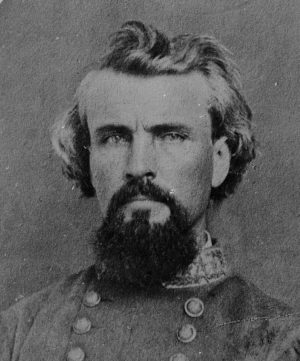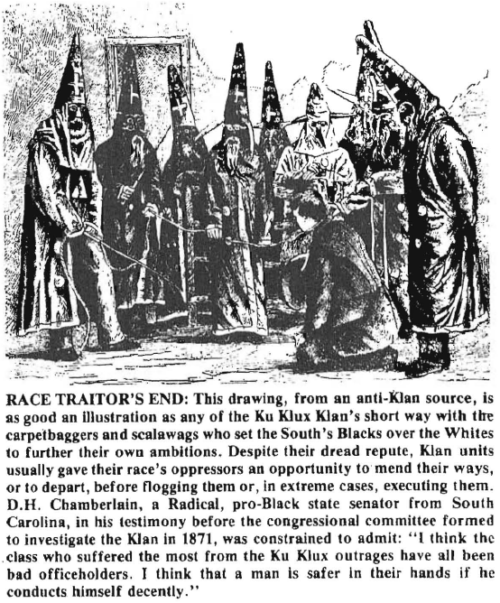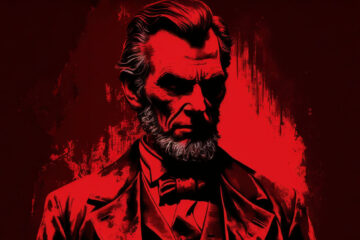The Shame of Reconstruction, part 2: The Whites Fight Back
 South’s leaders sparked White resistance, but lacked long-range ideas
South’s leaders sparked White resistance, but lacked long-range ideas
by Ted O’Keefe
AS THE EVENING shadows lengthened on the deserted streets of Franklin, Tennessee, Saul Bierfield sat amidst the piled wares of his prosperous dry-goods store, greedily devouring a watermelon. Two of his Black stock boys lounged beside him, gorging themselves on the pulpy red fruit. (ILLUSTRATION: Nathan Bedford Forrest)
Normally Bierfield would have had every justification for a rich and mellow satisfaction. Trade was booming, and it was the local Black freedmen who were his most devoted customers. The merchant considered himself to be a man without prejudice. He himself, a Russian Jew, could tell many tales of his misfortunes at the hands of the Russian Tsar — tales which gained from plaintiveness what they lacked in particulars. Weren’t the Blacks like the children of Israel, who had slaved for Pharaoh and then been delivered through the terrible mercy of Yahweh, the Almighty?
If there was cause to worry, it was entirely due to his support and leadership of the local Blacks. What had begun with his selling of firearms to the freedmen — entirely legal, indeed humane, according to his way of looking at it — had three weeks before escalated into violence. There had been some story of a young White girl raped by a Negro. Bierfield could sympathize with the poor Black fellow: He knew how cold and unyielding these shiksas could be.
What was unforgivable was that the girl’s brother, a young tough named Ezell, had taken it into his own hands to murder the defenseless Negro. Bierfield knew his obligations. The Black folk needed direction: Their afflictions were dire. Besides, he had considered, if he failed to help them they might take their business elsewhere.
So Bierfield had disguised himself in a long, flowing robe, saddled up his horse, and led a party of Blacks to seek out Ezell. On a deserted stretch of road outside Franklin, from behind the concealment of a wall, they had shot down the young White man like the dog he was.
The Jew’s only worry was that somehow the other Whites might find out. Not likely, though, he thought. They were smart, all right, far smarter than the Blacks. But not as smart as a Jew.
Sitting in the darkness with his two Black boys, Bierfield allowed himself a smile. What would they think back in the shtetl? Saul Bierfield, out-Cossacking the Cossacks, and turning a handsome profit to boot!
Bierfield was snapped from his reveries with a shock as the back door to his establishment burst open with a splintering crash. The two Blacks tried to stave off the masked, robed assailants, as Bierfield raced out the front door. One Negro, struck at close range by a large-caliber bullet, pitched over, mortally wounded. The other darted to safety out the back.
Ezell’s avengers caught up with Bierfield a hundred yards from the store. The merchant begged for his life. His old mother would die from the shock, Bierfield pleaded.
Four heavy horse pistols, of the type carried by Confederate cavalrymen during the Civil War, cracked simultaneously. The range was so close that Bierfield’s clothes were singed by the muzzle flashes. The Jew collapsed, rolled over once, and came to rest, face down, in the gutter. Churchgoers found his body there the next morning, Sunday, August 16, 1868.
* * *
Radical Reconstruction had an early start in Tennessee. The Union armies had conquered large parts of the state by the end of the war, and by that time there was already a functioning, if provisional, Union government, which enjoyed substantial support among the pro-Northern Whites in mountainous eastern Tennessee.
In 1865 William G. “Parson” Brownlow, a fire-eating Unionist during the war, was elected governor of the state. During the two postwar years in which the White Southerners in the other states which had seceded were slowly establishing a new political and social order on the ruins of the ante-bellum system, Brownlow was setting up a full-blown Radical regime.

Brownlow, who controlled the electoral machinery, denied ex-Confederates the vote, while enfranchising the Black freedmen. Whites who had taken part in the secession were forbidden to carry weapons, while Brownlow organized his Black supporters into companies of riflemen. The situation General J.H. Clanton described in Alabama in his testimony before a congressional committee in 1871 held true in Tennessee: “The White people did not go to the polls . . . . But the Negroes marched to the polls by battalions, armed with muskets and stepping to the beat of drums.”
The Blacks, whipped to a frenzy by the carpetbag leaders of the Loyal Leagues, engaged in an orgy of murder, rape, arson, and theft. Brownlow’s administration greeted these outrages with indulgence, often securing the release of Black offenders within hours of their capture. Where the Blacks did not resort to outright criminality, they assumed a swaggering arrogance toward the less prosperous Whites, aping some of their former plantation masters in contempt for the “po’ White trash.”
It was a foregone conclusion that the Whites of Tennessee, most of whom had supported withdrawal from the Union in the face of far less onerous grievances, would attempt to defend themselves by whatever means came to hand. The rise of White resistance to Brownlow’s tyranny, nevertheless, came from an unexpected quarter.
As six young Confederate veterans whiled away a late December evening in a Pulaski, Tennessee, law office in 1865, one of them hit upon the idea of founding a social club to relieve the drabness and misery of postwar existence. The club was to be purely for amusement, drawing on college fraternities and secret societies for its rituals and by-laws.
As the embers in the fireplace died down, the six outbid each other in enthusiasm for the projected society. Its members would be initiated with weird rites. Each of the men assumed a grandiloquent title of office.
The founders devised a grotesque costume, consisting of flowing robes, a peaked hat, and an eerie mask. One member proposed the name Kuklux, inspired by kyklos, the Greek word for circle, and another completed it with the alliterative Klan, doubtless called to mind by the founding members’ Scots-Irish ancestry.
The first six Klansmen, McCord, Lester, Kennedy, Crowe, Jones, and Reed, began the circumspect recruitment of friends for the embryonic fraternal group. Soon the Kuklux Klan was large enough to stage a bizarre procession through the streets of Pulaski. The Klansmen, mounted on horses, wrapped in sheets decorated with mysterious emblems, greatly heartened their fellow Whites by their skylarking pratfalls and evident good humor.
But the Klansmen observed a curious reaction among one segment of Pulaski’s residents. The town’s Blacks, frightened by the masked apparitions, fled to their homes in terror. The fledgling club’s members were not long in taking to heart the lesson of this incident; they quickly recognized the Kuklux Klan’s potential for restoring order among the Blacks of surrounding Giles County. At first, force was not needed to intimidate the freedmen: The spectral effect of the ghostly, hooded riders sufficed.
The Klansmen perfected a number of pranks which played on the Blacks’ superstitious fears. One tactic was to visit an unruly Negro after dark and to have one of their number ask for a drink of water. When offered the usual drinking gourd, he would toss it away and ask for the whole bucket. Then the Klansman would drain the pail without stopping for breath, thanks to the aid of a funnel behind his mask, which was connected by a rubber hose to an oilcloth bag beneath his robe.
This feat accomplished, the horseman would remark in sepulchral tones, “That was good. That’s the first drink I’ve had since I was killed at the battle of Shiloh, and you get mighty thirsty down in Hell.” If the bug-eyed Negro didn’t run off then and there, gibbering in panic, he found ample reason to reform his conduct.
The Kuklux Klan grew rapidly during the fall of 1866 and the following winter, as its reputation for effectiveness spread among Whites of the neighboring counties. When at last a Black had the presence of mind to fire shots at the white-robed riders, wounding a Klansman, the myth of the Klan’s ghostly incorporeality was broken. The White raiders began to dye their robes in less visible reds and blacks and to rely increasingly on their revolvers and rifles.
As additional Klan chapters, or dens, as they were called, blossomed throughout central and western Tennessee, there developed a need for a more efficient, centralized command. The rapidly proliferating units were often undisciplined and had only an in formal allegiance to the Pulaski den, which in any case had not been organized with the intention of serving as the command center of a White resistance movement.
In April 1867 a number of Tennesseans met at Maxwell House, a leading hotel in Nashville. There they reorganized the Ku Klux Klan, as it was known from that time, on a more formal, hierarchical basis. General Nathan Bedford Forrest, CSA, one of the leading tacticians of the Civil War, accepted the leadership of the movement, taking the fanciful title of “Grand Wizard.” (The colorful and, to a large extent, nonsensical names for leaders and units were standardized at this time.) General George Gordon, CSA, drafted a constitution, known as the “prescript,” which laid out the Klan’s purpose and procedures.
It would be an exaggeration to characterize the “Invisible Empire,” even after the Nashville meeting, as a centralized, consciously revolutionary movement. Local initiatives in response to local circumstances were still the rule, although there was often a high degree of cooperation and interaction between neighboring dens.
Nonetheless, the re-organized, streamlined Klan units had little difficulty in sending Governor Brownlow’s Black-and-Tans militias reeling in disarray. Brownlow had little better luck in his efforts to gain the support of the Federal garrison in Tennessee. General Thomas, the “Rock of Chickamauga,” despite his service on the Northern side during the Civil War, did not hasten to assist in the suppression of his fellow Whites. During the remainder of 1867 and throughout 1868 the lot of the carpetbaggers, scalawags, and Negro freedmen of Tennessee deteriorated mightily.
“Parson” Brownlow rushed through laws and more laws, with scant effect. The enactment of the most draconian penalties failed to stay the onslaught of the Klan, which was by then rampant in northern Alabama and the Piedmont area of North and South Carolina as well as in Tennessee.
The race traitors among the Whites now trembled in terror at the implacability of the night riders. One A.H. Eastman, an agent of the Freedmen’s Bureau at Murfreesboro, testified before a congressional committee set up to investigate the Ku Klux Klan that he had found it expedient to sleep with a revolver under his pillow, “a double-barreled shotgun, heavily charged with buckshot, at one hand, and a hatchet at the other, with an inclination to sell the little piece of mortality with which I am entrusted as dearly as possible.”
 The clergymen who had flocked south to instill in the Blacks delusions of a God-given equality now experienced many a dark night of the soul. As one man of the cloth wrote, “To be for weeks in constant expectation of being murdered or burned out, and without losing faith in God, is something of a strain on the nerves.”
The clergymen who had flocked south to instill in the Blacks delusions of a God-given equality now experienced many a dark night of the soul. As one man of the cloth wrote, “To be for weeks in constant expectation of being murdered or burned out, and without losing faith in God, is something of a strain on the nerves.”
In a typical incident, a White mob disrupted a Methodist service at Berryville, Tennessee, which was being conducted by a carpetbagging preacher from Baltimore. The parson took to his heels with bullets singing past his ears and was not seen in that district again.
* * *
Ryland Randolph, Klansman
Ryland Randolph, “Grand Cyclops” of the Ku Klux Klan den in Tuscaloosa, Alabama, was typical of the men who led the original Ku Klux Klan. A journalist, he published and edited the Tuscaloosa Independent Monitor, quickly turning it into a devastatingly effective organ for pro-White propaganda.
Like almost all the details of the Klan’s organizational history, Randolph’s role in founding the Tuscaloosa unit is obscure. What is certain is that the rise of the Klan in Tuscaloosa occurred shortly after “Imperial Wizard” Nathan Bedford Forrest made what was advertised as a “speaking tour” through northern Alabama in early 1868. That spring Randolph began to print Klan notices and warnings in his newspaper, feigning ignorance as to their source. He reported the alleged receipt of a bloodcurdling message from the “Grand Cyclops,” who was left unidentified:
“Cyclops warns it — print it well,
Or glide instanter down to hell.”
As the rise of Klan activity in Alabama elicited the same panicky response from Federal officials and from the carpetbaggers and scalawags who were their creatures as it had in Tennessee, Randolph hammered at the race traitors with biting ridicule. When General Shepherd, commander of the military district which included Alabama, issued a general order aimed at suppressing the movement, Randolph compared him in an editorial to “Xerxes, madly lashing the waves of the Hellespont in his impotent wrath at their destruction of his bridge of boats, and Canute coolly commanding the tide to retire from his approach.”
Randolph also led the fight against the appointment of the Reverend A.S. Lakin, a carpetbagging Methodist minister, to the presidency of the University of Alabama. Lakin was swept out of his post after one day on a wave of vituperative rhetoric, all the more potent through the preacher’s knowledge that it was by no means idle, which culminated in Randolph’s ominous prediction of a lynching bee which would leave Lakin, in the journalist’s colorful phrase, “a feast for anthropophagous vermin.”
Let it not be imagined that the pen was Randolph’s only weapon. Although his nighttime forays remain veiled in darkness and cloaked in the robes of the Klan, one public incident revealed his courage by the light of day. When a hulking and arrogant Black, Balus by name, made so bold as to insult a White woman on a crowded street, Randolph leapt to her defense. Despite the presence of a crowd of the Black’s friends, the chivalrous journalist drew his knife, slashed Balus across the face, and then thrashed him with his bare hands.
The incident inspired Randolph to write an editorial entitled “Niggers, Radicals, and Ghosts,” in which he remarked, with pardonable satisfaction, “The cutting and beating of the insolent fellow Balus on the 28th ult. in the presence of crowds of his fellow niggers has had a salutary influence on the whole of niggerdom hereabouts. They now feel their inferiority, in every particular, to the White man.”
They don’t make American newspapermen the way they used to!
* * *
Governor Brownlow decided to destroy the Klan through infiltration. To this end he hired Seymour Barmore, a Cincinnati private eye who billed himself as “the greatest detective in the world.” Barmore, whose plum-colored pantaloons, velvet jackets, and glittering diamond stickpins seemed hardly to jibe with the common notion of the plainclothesman, actually succeeded in infiltrating the Pulaski den, which the authorities evidently thought still exercised command. This piece of cloak-and-dagger handiwork was not crowned with success, however: Several weeks later the corpse of the world’s greatest detective was fished from the Duck River at Booker’s Ferry Bridge.
The Klan’s activities sparked a surge of enthusiasm among the Whites, while totally demoralizing Tennessee’s Black population. In 1869 the Negroes stayed away from the polls in droves, and Brownlow’s Radical Republican regime gave way to a pro-White Democratic administration.
The Ku Klux Klan did not long outlive Brownlow’s government of carpetbaggers and scalawags, however. Its success inspired the passage and enforcement of radical measures designed to root out White militant activity through the massive employment or Federal troops and through highhanded (and unconstitutional, as the Supreme Court later determined) legal practices, including the denial of habeas corpus.
Three so-called “force bills” passed by Congress in 1870 and 1871 provided stringent penalties for resisting the Black-and-Tans Reconstruction regimes. Nine counties in South Carolina were placed under direct military control, and hundreds of White activists were arrested and thrown into jail by military tribunals.
Just as instrumental in the Klan’s decline was the movement’s nature as a localized, rural, pre-industrial secret society. The fetish for secrecy and mystery made it difficult for the public to understand the Klan’s aims (Klan notices were typically phrased in studiedly illiterate doggerel).
Individual dens acted on the whims of their leaders and members, with sometimes strange results: A number of Klan units even allowed “decent, upstanding” Blacks to take part in their activities. Finally, certain Klan chapters had gotten out of hand, and spurious dens had sprung up, in which thieves and brigands traded on the anonymity and prestige conferred by Klan robes to carry out various crimes.
Thus, by 1871 at the latest, General Forrest had officially disbanded the Klan. It had accomplished excellent work in fanning the sparks of White resistance into flames, but the Klan’s fire had run its course.
Contemporaneously with the rise of the Ku Klux Klan in the Piedmont, other White resistance groups had sprung up in the Black Belt of Mississippi and Alabama, as well as in Louisiana and the Tidewater region of North and South Carolina. Some of them were more moderate on the race question than the Klan; some, like the Knights of the White Camelia, which flourished in Louisiana, exceeded the Klan in the single-mindedness with which they strove for White racial integrity.
All these movements for the restoration of White rule were hard hit by the tyrannical measures imposed by the Republican regime in Washington. The reconstructed state governments relied increasingly on force, supplied by Federal troops and marshals, to shore up their crumbling authority.
The pace of Radical counterattacks against the resurgent Whites of the South could not long be maintained, however. Despite Grant’s sweeping victory against Horace Greeley in the 1872 election, his support quickly began to unravel in the face of popular disgust at the venality and corruption which extended to the highest levels of the Grant administration.
The great depression which began in 1873 drained further support from Grant and the Radicals, as the Northern public became less disposed to lavish money and manpower on the costly business of keeping the former states of the Confederacy under military occupation and supervision.
Meanwhile, in the South the changing circumstances were giving rise to a new sort of movement, which combined the emphasis on armed resistance of the earlier White groups with a comprehensive strategy for political action. Organizations like the Red Shirts in South Carolina and the White League in Louisiana, which comprised a broad social spectrum and were generally led by planters and merchants, employed both bullets and ballots in their attempts to unseat the increasingly beleaguered Reconstruction governments.
One such development was the White militias and political unions organized in Mississippi. Collectively styled the “Mississippi plan” for challenging carpetbagger, scalawag, and Black rule, these groups differed from the Ku Klux Klan in that only their procedures and rituals were kept secret: The Whites who belonged to them made no attempt to conceal their membership. On the contrary, they drilled openly with rifles and even artillery. The Mississippians took particular care to disrupt Republican rallies, a standard tactic being to mass on horseback, armed to the teeth, and then to circle menacingly around the assembled and by then cowed Blacks, with loud hints as to the possibility, as the White riders put it, that they “might kill some bucks today.”
By 1872 the Whites of Mississippi and the other Southern states had begun to make real headway at the polls. The year before, the ironclad oath required of White voters, by which White Southerners swore that they had done nothing to aid in the secession, had been abolished. All but 750 former Confederates were eligible to vote and hold office. Rising Democratic (i.e., White) strength at the polls led to ever more numerous electoral victories and forced the remaining Southern Radical regimes to ever more dubious expedients to retain power.
Outright electoral fraud on the part of the Republicans was now accompanied by the use of force to reverse the outcomes of unfavorable ballotings. In Louisiana, in 1872, the Democrats won a sweeping victory, which Governor Kellogg’s Radical regime refused to recognize. For several months rival state legislatures, Republican and Democrat, sat, and two self-proclaimed governors confronted each other, before Federal troops suppressed the pro-White Democrats. In Arkansas rival Republican factions fought a miniature civil war over control of the statehouse, which left more than 200 dead.
As the ranks of eligible White voters swelled, the Whites struck at the Radicals’ Achilles heel, the Black voters on whom their political strength rested. The pervasive ignorance and illiteracy of the Blacks made them easy prey for Democratic maneuvers. As one earnest Black voter expressed it, “I can’t read, and I can’t write . . . We go by instructions. We don’t know nothing much.”
One successful ruse involved distributing false ballots to Blacks. Since so few Blacks could read, their ballots were often adorned by a pictorial symbol of the Republican Party, such as the Liberty Bell or some appropriate animal. In one small town in Georgia, White activists distributed hundreds of pieces of paper bearing pictures of rats, representing them to the befuddled Negroes as ballots. The election produced a landslide for Costar’s Rat and Cockroach Exterminators, but a white Democrat represented that district in the state legislature when it convened the next year.
By 1875 only Florida, Mississippi, South Carolina, and Louisiana remained unpurged of the anti-White regimes of the carpetbaggers and scalawags. The following two years witnessed White campaigns of unprecedented fervor and organizational skill in each of these four states. In Louisiana, Mississippi, and South Carolina, well-trained, disciplined White militias fought pitched battles with Black troops, invariably defeating them with heavy losses. As carpetbagger Governor Adalbert Ames of Mississippi lamented, the Blacks had “not the courage or nerve — whatever it may be called — to act the part of soldiers.”
General Wade Hampton’s campaign for governor of South Carolina in 1876 marked the climax of the drive for White supremacy. Torchlight parades, giant rallies which featured stirring speeches and music, conspicuous public drilling by red-shirted White riflemen: all contributed to galvanize enthusiasm for the restoration of White rule. Hampton won a handy victory at the polls, and despite the efforts of Governor Chamberlain, a Radical Republican, to steal the election, the Democrat was inaugurated early the next year.
There was a discordant note in the Hampton campaign, however. The Democrats eagerly sought Black votes, and law-abiding, pro-Democratic Blacks took part in Hampton rallies. White leaders, many of them planters anxious to cultivate this source of cheap labor, carried on similar solicitations for Black support in the other Southern states.
When in 1877 the disputed presidential election of the previous year was decided in favor of Republican candidate Rutherford B. Hayes, the Southern Whites were able to extract substantial concessions in exchange for their acquiescence in certifying Hayes the winner. The last of the carpetbag state governments were dismantled, and the military occupation of the former Confederate states came to an end.
Over the following two decades the Whites of the American South created an elaborate system of segregation to safeguard the integrity of their race. The Jim Crow laws were far from a solution, however, to the desperate problem posed by the presence of millions of Negroes in the midst of a White civilization. The Blacks received a new dispensation, and for Whites, both in the North and in the South, the segregation system came to assume a status similar to that of the plantation-based slave economy: Once again, the South was burdened by a “peculiar institution.”
There is no doubt that the struggle to overthrow the tyrannical and treasonous regime of the Radical Reconstructionists in the South was the most inspirational political movement in American history. It must not be forgotten, however, that it achieved only a limited and conditional success, which gave way, within a century, to the second and final defeat of the South’s racial-national aspirations. We White Americans of the present day who organize to secure the survival and progress of our race must build better than our forefathers did.
* * *
Source: National Vanguard tabloid, No. 72, 1979; as published in the book The Best of Attack! and National Vanguard Tabloid, edited by Kevin Alfred Strom; transcribed by Vanessa Neubauer






I must thank you for the many extremely interesting and highly educational articles you publish.
Southern whites were remarkably restrained during the period usually referenced (1877 to 1950), as fewer than 4,000 blacks were lynched. Projecting the current levels of black criminality against whites onto the millions of unrestrained blacks, over those 73 years, and many more lynchings would seem justified for the rape, robbery, assault and murder they committed.
Lifted from a Harvard encyclopedia, a New England professor wrote: : The South defeated Reconstruction with great energy and ingenuity.” The Black Republicans achieved an empty victory, which explains why the South was reinvaded in the 1960s, i.e., the 2d Reconstruction. Cullen Baker’s East Texas Guerillas continued the fight after the war. On the first anniversary of Lincoln’s assassination, Eugene Williams offered a toast to John Wilkes Booth: “Here is to the man that pulled the trigger — That killed the man that freed the nigger.” “John Long said of the Yankees traveling through East Texas: “They have behaved very well traveling through our country, or they would have been picked off at every cluster of bushes. The negroes have been giving some trouble, but by hanging one every once… Read more »